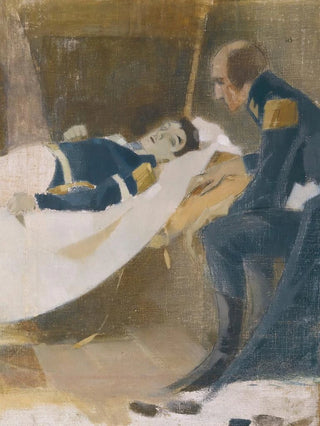Art print | The Death of Wilhelm von Schwerin - Helene Schjerfbeck


View from behind

Frame (optional)
In the world of art, certain works transcend the simple frame of the canvas to become profound reflections on the human condition. "The death of Wilhelm von Schwerin" by Helene Schjerfbeck fits into this tradition. This poignant piece evokes the fragility of life and the beauty of passing. It invites us to contemplate not only the depicted scene but also the emotions and memories it awakens. Through a delicate palette and forms that are both simple and evocative, Schjerfbeck manages to capture the very essence of mortality, immersing us in a universe imbued with melancholy and tenderness.
Style and uniqueness of the work
Schjerfbeck's style is often associated with a modernist approach, where the simplification of forms and the use of subtle color combine to create a unique atmosphere. In "The death of Wilhelm von Schwerin," this singularity is expressed through a delicate treatment of the characters and surrounding elements. The composition, both intimate and universal, allows the viewer to feel the depth of the conveyed emotions. The delicate, almost sketched traits, testify to an artistic sensitivity that goes beyond mere representation. Each brushstroke seems charged with meaning, inviting an introspective exploration of themes of loss and memory. This art print, through its ability to evoke universal feelings, is part of an artistic tradition that seeks to capture the invisible.
The artist and her influence
Helene Schjerfbeck, an emblematic figure of Finnish art, has established herself through her personal style and unique vision. Born in 1862, she navigated the artistic movements of her time, integrating elements of post-impressionism and symbolism into her work. Her introspective approach and her ability to translate complex emotions into images made her a pioneer in the art world. "The death of Wilhelm von Schwerin" perfectly illustrates her capacity to address heavy subjects with apparent lightness, while maintaining a striking emotional depth. Schjerfbeck's influence extends well beyond the borders of Finland,

Matte finish

View from behind

Frame (optional)
In the world of art, certain works transcend the simple frame of the canvas to become profound reflections on the human condition. "The death of Wilhelm von Schwerin" by Helene Schjerfbeck fits into this tradition. This poignant piece evokes the fragility of life and the beauty of passing. It invites us to contemplate not only the depicted scene but also the emotions and memories it awakens. Through a delicate palette and forms that are both simple and evocative, Schjerfbeck manages to capture the very essence of mortality, immersing us in a universe imbued with melancholy and tenderness.
Style and uniqueness of the work
Schjerfbeck's style is often associated with a modernist approach, where the simplification of forms and the use of subtle color combine to create a unique atmosphere. In "The death of Wilhelm von Schwerin," this singularity is expressed through a delicate treatment of the characters and surrounding elements. The composition, both intimate and universal, allows the viewer to feel the depth of the conveyed emotions. The delicate, almost sketched traits, testify to an artistic sensitivity that goes beyond mere representation. Each brushstroke seems charged with meaning, inviting an introspective exploration of themes of loss and memory. This art print, through its ability to evoke universal feelings, is part of an artistic tradition that seeks to capture the invisible.
The artist and her influence
Helene Schjerfbeck, an emblematic figure of Finnish art, has established herself through her personal style and unique vision. Born in 1862, she navigated the artistic movements of her time, integrating elements of post-impressionism and symbolism into her work. Her introspective approach and her ability to translate complex emotions into images made her a pioneer in the art world. "The death of Wilhelm von Schwerin" perfectly illustrates her capacity to address heavy subjects with apparent lightness, while maintaining a striking emotional depth. Schjerfbeck's influence extends well beyond the borders of Finland,






